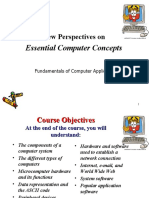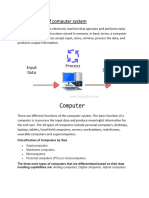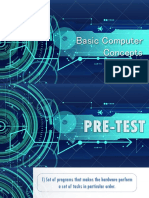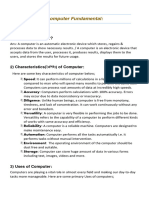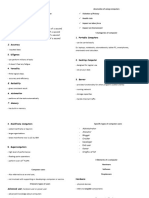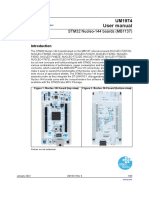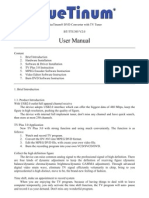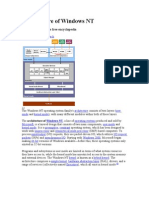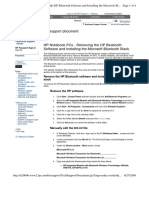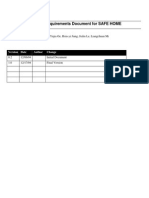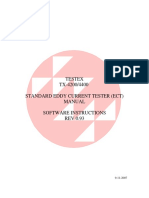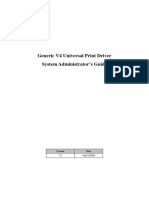Kohat University of Science & Technology
Institute of Computing
Subject: Information and Communication Technologies (ICT) 1st Week
Topic: Fundamentals of Computer Instructor: Abdur Rehman
Q. Define ICT?
Ans: Information and Communication Technologies (ICT) refers to all the tools and
systems that help people create, store, share, and use information.
This includes computers, the internet, mobile phones, software, and networks that
allow communication and data exchange
*********************
Q. Define computer?
Ans: A computer is an electronic device that takes input (data), processes it using
instructions (software), and produces output (results). It can store information, perform
calculations, and help in various tasks like writing documents, browsing the internet,
playing games, and more.
Computers come in different forms, such as desktops, laptops, tablets, and
smartphones.
Simple Computer Working Diagram
*********************
1
�Q. Define Hardware and Software with example.
Ans:
Hardware and Software Definitions with Examples
1. Hardware: The physical parts of a computer that you can touch and see.
o Example: Keyboard, mouse, monitor, printer, hard drive, CPU, RAM.
2. Software: The programs and instructions that run on a computer and tell it what
to do.
o Example: Microsoft Word (used for typing documents), Google Chrome
(used for browsing the internet), Windows (operating system), and games
like PUBG.
👉 Hardware is like the body of a computer, and software is like its brain that controls
it.
*********************
Q. Briefly describe various input and output devices of computer.
Ans:
Input and Output Devices of a Computer
1. Input Devices
Input devices are used to enter data and instructions into the computer.
Examples:
Keyboard – Used for typing text and commands.
Mouse – A pointing device to select and interact with items on the screen.
Scanner – Converts physical documents into digital form.
Microphone – Captures sound input for recording or communication.
Webcam – Captures video input for video calls and recording.
2. Output Devices
Output devices display or produce the result of computer processing.
2
�Examples:
Monitor – Displays visual output like images, videos, and documents.
Printer – Produces a hard copy (printed paper) of digital documents.
Speakers – Output sound from the computer.
Projector – Displays computer output on a larger screen for presentations.
👉 In simple words, input devices help us give instructions to the computer, and output
devices show us the results.
*********************
Q. Briefly explain in what different shapes and tasks a computer is used in today's
world.
Ans: Different Shapes and Uses of Computers in Today's World
Computers come in various shapes and sizes, performing different tasks in our daily
lives.
1. Shapes of Computers
Desktop Computers – Large, powerful computers used in offices and homes.
Laptops – Portable computers for work, study, and entertainment.
Tablets – Touchscreen devices used for browsing, reading, and drawing.
Smartphones – Small, handheld computers used for communication and apps.
Servers – Powerful machines that store and manage data for websites and
networks.
Supercomputers – Extremely fast computers used for scientific research and
complex calculations.
Embedded Systems – Small computers inside devices like washing machines,
ATMs, and cars.
2. Tasks Performed by Computers
Education – Online learning, research, and digital classrooms.
Business – Managing data, online meetings, and financial transactions.
3
� Healthcare – Patient records, medical imaging, and robotic surgeries.
Entertainment – Gaming, streaming movies, and music production.
Communication – Emails, video calls, and social media.
Banking – Online banking, ATMs, and digital transactions.
Transportation – GPS navigation, self-driving cars, and airline ticketing.
👉 Computers are now an essential part of every industry, making life easier and more
efficient.
*********************
Q. Briefly state advantages and limitation/disadvantages of computers.
Ans:
Advantages and Limitations of Computers
✅ Advantages of Computers
1. Speed – Computers process data and perform calculations much faster than
humans.
2. Accuracy – They provide highly accurate results with minimal errors.
3. Automation – Computers can perform repetitive tasks without human effort.
4. Storage – They can store large amounts of data securely.
5. Connectivity – Enables instant communication through emails, video calls, and
social media.
6. Multitasking – Can run multiple programs at the same time.
7. Entertainment – Used for gaming, music, movies, and creative applications.
8. Research & Learning – Provides access to vast knowledge through the internet.
❌ Limitations/Disadvantages of Computers
1. Dependence on Electricity – Most computers need power to function.
2. Cybersecurity Risks – Data can be hacked, leaked, or attacked by viruses.
4
� 3. Lack of Creativity – Computers follow instructions and cannot think like humans.
4. Health Issues – Excessive use can cause eye strain, obesity, and posture
problems.
5. Unemployment – Automation can replace human jobs in some industries.
6. High Cost – Advanced computers and software can be expensive.
7. Data Loss – Hardware failures or software crashes can lead to data loss.
👉 While computers offer many benefits, they also have some challenges that require
proper management and security.
*********************
Q. What are different types of software? Briefly describe.
Ans:
Types of Software
Software is a set of programs that tells a computer what to do. It is mainly divided into
two main types:
1. System Software
This software manages the hardware and provides a platform for other software to run.
Examples:
Operating System (OS) – Controls the computer (e.g., Windows, macOS, Linux,
Android).
Device Drivers – Help the OS communicate with hardware (e.g., printer driver,
graphics driver).
Utility Software – Performs maintenance tasks (e.g., antivirus, disk cleanup,
backup software).
2. Application Software
These are programs designed for users to perform specific tasks.
Examples:
Productivity Software – Helps in work (e.g., Microsoft Word, Excel, Google Docs).
5
� Media Software – Used for music, videos, and editing (e.g., VLC Player, Adobe
Photoshop).
Communication Software – Enables online communication (e.g., WhatsApp,
Zoom, Gmail).
Gaming Software – Video games for entertainment (e.g., PUBG, Call of Duty).
👉 In simple terms, system software runs the computer, while application software
helps users complete tasks.
*********************
Q. Define data and its types with simple example.
Ans:
Definition of Data
Data is raw facts and figures that have no meaning on their own until processed. It can
be in the form of numbers, text, images, or sounds.
Example:
Raw Data: "Ali, 25, Pakistan" (This alone does not mean much.)
Processed Data (Information): "Ali is 25 years old and lives in Pakistan."
Types of Data
1. Text Data – Letters, words, and sentences.
o Example: "Hello, how are you?"
2. Numeric Data – Numbers used for calculations.
o Example: 123, 45.67
3. Image Data – Pictures or graphics.
o Example: A photo of a person or a diagram.
4. Audio Data – Sound or voice recordings.
o Example: A song or a recorded lecture.
5. Video Data – Moving images with sound.
o Example: A YouTube video.
👉 In short, data is raw information that can be processed to make it meaningful.
*********************
6
�7











